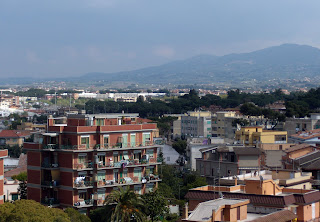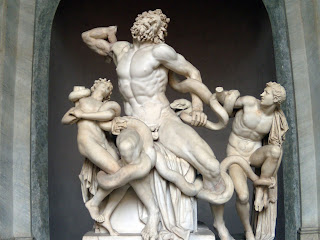We arrived on Friday and were able to visit a shopping mall. I know, I know, why would the first thing we do in one of the most historic cities be to shop at a centro commercial? Well, A's cousins were nice enough to take us around. Both A and I have traveled to Rome a few times in the past. We only had a few items on our list to see. All I'm going to say about the mall is that it was very posh and there was a giant supermarket inside of it! To me, this was quite strange, but it's apparently becoming the norm in Italian malls.
When we weren't shopping, we were visiting with the aunt and uncle in their beautiful apartment. Here are some photos of the landscape from their home!


During our stay with the family, we were able to run around on our own and visit some important points of interest. Topping our list was a trip to the Vatican museum. I haven't been in this museum in 5 years and they have opened up a new wing.



In this new wing, there is a famous sculpture of Augustus. Though it's probably not the original one, you see a lot of copies all around the Roman streets.

We journeyed on among the hoards of tour groups in order to get a good picture of Laocoon and his sons. This is the famous statue depicting the Trojan Laocoon, who warned his fellow citizens that the giant wooden horse the Greeks offered as a gift was a trap. According to the story, deadly snakes came out of the wilderness and attacked Laocoon and his sons. The Trojans took this tragedy as a sign and ignored Laocoon's warnings.

For the sake of brevity, here are a few of the highlights from the Vatican Museum. There is "The School of Athens" by Raphael.

Here's the ceiling in the Gallery of Maps.

Finally, here's a sculpture known as the Belvedere Torso. If you're anything like me, you're wondering why this broken sculpture is of note. According to A, Michelangelo was very impressed with this piece and would devote many of his drawings and paintings to imitiating this form. Once you study it for a few moments, you recognize some figures in the Sistine Chapel ceiling with a similar physique.

No trip to the Vatican Museum is complete without a walk around St. Peter's Basilica.

We crossed this interesting bridge over the Tiber River in order to return into Rome. I was conflicted; part of me wanted to gaze at all the beautiful art that seeped through the city, while the other part of me wanted to bolt home for more Italian cooking!

On our walk to the metro, we saw Altar of the Fatherland. I love this building/monument. It depicts the first king to rule a unified Italy, Victor Emmanuel.

Here's my attempt to be a deep photographer. It's a profile of the Emmanuel statue.

I feel this is a fitting place to end this post. I will upload more photos as soon as possible because there are many more statues, monuments and volcano threats! To be continued...













